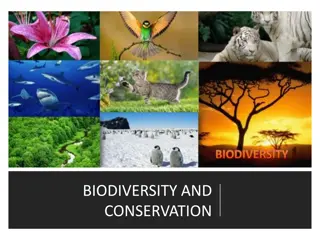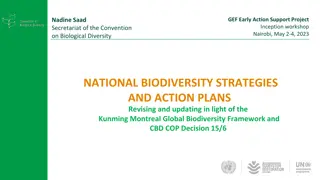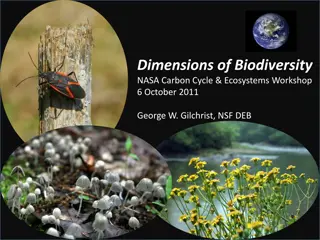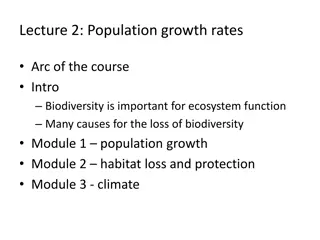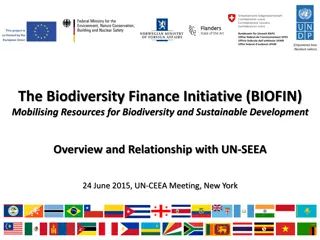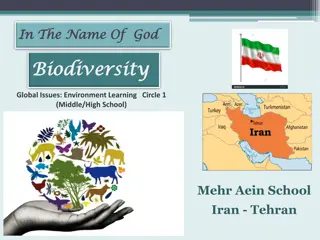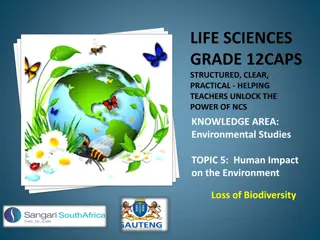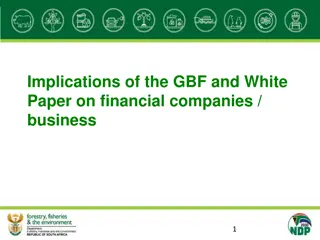
EU's Role in Biodiversity & Climate Solutions
The European Union has played a significant role in addressing biodiversity loss, deforestation, and climate change through conventions and strategies. The legal basis outlined in the Treaty on the Functioning of the European Union reflects the Union's commitment to environmental protection and sustainable development. Explore the EU's efforts towards conserving biodiversity and combating climate change.
Download Presentation

Please find below an Image/Link to download the presentation.
The content on the website is provided AS IS for your information and personal use only. It may not be sold, licensed, or shared on other websites without obtaining consent from the author. If you encounter any issues during the download, it is possible that the publisher has removed the file from their server.
You are allowed to download the files provided on this website for personal or commercial use, subject to the condition that they are used lawfully. All files are the property of their respective owners.
The content on the website is provided AS IS for your information and personal use only. It may not be sold, licensed, or shared on other websites without obtaining consent from the author.
E N D
Presentation Transcript
JEAN MONNET MODULE DOHA COURSES ON EUROPEAN UNION LAW FALL 2021 DR. JON TRUBY
Biodiversity, Land Use and Forestry
Introduction The EU has played an important international role in seeking solutions to biodiversity loss, deforestation and climate change. The 1992 UN Conference on the Environment and Development marked a major step forward for the conservation of biodiversity and the protection of nature thanks to the adoption of the Convention on Biological Diversity. In 2011, the EU committed itself to halting the loss of biodiversity and the degradation of ecosystem services in the EU by 2020.
Introduction The 2015 Paris Agreement on climate change notes the importance of ensuring the integrity of all ecosystems and the protection of biodiversity. As part of the European Green Deal, the Commission has proposed a new biodiversity strategy that aims to put Europe s biodiversity on the path to recovery by 2030, for the benefit of people, the climate and the planet.
Legal Basis: Articles 3, 11 and 191-193 (previously examined) of the Treaty on the Functioning of the European Union (TFEU). Article 3 1. The Union shall have exclusive competence in the following areas: (a) customs union; (b) the establishing of the competition rules necessary for the functioning of the internal market; (c) monetary policy for the Member States whose currency is the euro; (d) the conservation of marine biological resources under the common fisheries policy; (e) common commercial policy.
Legal Basis: Articles 3, 11 and 191-193 (previously examined) of the Treaty on the Functioning of the European Union (TFEU) 2. The Union shall also have exclusive competence for the conclusion of an international agreement when its conclusion is provided for in a legislative act of the Union or is necessary to enable the Union to exercise its internal competence, or in so far as its conclusion may affect common rules or alter their scope. Article 11: Environmental protection requirements must be integrated into the definition and implementation of the Union's policies and activities, in particular with a view to promoting sustainable development.
General Background The UNCED in 1992, led to the adoption of the UN Framework Convention on Climate Change (UNFCCC) and of the Convention on Biological Diversity (CBD), as well as to the Rio Declaration, a Statement of Forest Principles and theAgenda 21 programme. The CBD is complemented by two major protocols: 1. Cartagena Protocol on Biosafety, which was adopted in 2000 and entered into force in 2003, seeks to protect biodiversity from the potential risks posed by living modified organisms resulting from modern biotechnology; 2. Nagoya Protocol on Access and Benefit-Sharing, which was adopted in 2010 and entered into force in 2014, aims to create greater legal certainty and transparency for both providers and users of genetic resources.
General Background However, the CBD s report entitled The Global Biodiversity Outlook 3 shows that the 2010 biodiversity target was not met. In 2010 in Nagoya (Aichi Prefecture, Japan), the Parties to the CBD also adopted a revised strategic plan incorporating the Aichi Biodiversity Targets: 20 ambitious targets organised in five strategic goals to achieve biodiversity protection by 2020, as part of a strategic biodiversity plan for the 2011-2020 period.
General Background The EU is also a party to the following conventions: - Ramsar Convention on the Conservation of Wetlands (February 1971); - CITES convention (March 1973); - Bonn Convention on the Conservation of Migratory Species of Wild Animals (June 1979); - Bern Convention on the Protection of European Wildlife and Natural Habitats (1982); - Rio de Janeiro CBD (June 1992); and regional conventions
Objectives and Achievements
Biodiversity Action Plans In May 2006 the Commission adopted a communication and an action plan entitled Halting the loss of biodiversity by 2010 and beyond: Sustaining ecosystem services for human well-being . As the EU was unlikely to meet its 2010 target of halting biodiversity decline, a new strategy was adopted by the Commission in June 2011 in order to halt the loss of biodiversity and the degradation of ecosystems services in the EU by 2020, and restore them , while stepping up the EU contribution to averting global biodiversity loss .
Biodiversity Action Plans In December 2011 the Council endorsed the EU biodiversity strategy to 2020, incorporating the following six targets: - Implementation of EU nature legislation so as to protect biodiversity; - Better protection of ecosystems and greater use of green infrastructure; - More sustainable agriculture and forestry; - Better management of fish stocks; - Tighter controls on invasive alien species; - Bigger EU contribution to averting global biodiversity loss.
Conservation of Natural Habitats and of Wild Fauna and Flora The Habitats Directive (Council Directive 92/43/EEC on the conservation of natural habitats and of wild fauna and flora, amended by Directive 97/62/EC) established a European network, Natura 2000. It comprises Sites of Community Interest / Special Areas of Conservation designated by Member States, and Special Protection Areas classified pursuant to Directive 79/409/EEC on the conservation of wild birds. The amended Birds Directive (2009/147/EC) management and control of (wild) birds, including rules for sustainable hunting. covers the protection,
Invasive Alien Species (ISA) IAS cause damage amounting to billions of euros every year in the EU, not only to ecosystems but also to crops and livestock, disrupting local ecology and affecting human health. A key feature of Regulation (EU) No 1143/2014 on the prevention and management of the introduction and spread of IAS is the list of IAS of Union concern. The regulation seeks through prevention, early warning and rapid response to protect native biodiversity and to minimise and mitigate the impact of such species on human health and the economy.
Access and Benefit-Sharing The Commission presented a proposal in October 2012 with a view to laying down binding requirements for access to genetic resources in the country of origin and ensuring that the benefits are fairly and equitably shared. An agreement between Parliament and the Council led to the adoption of Regulation (EU) No 511/2014. Genetic resources and traditional knowledge associated with such resources can only be transferred and utilised in accordance with terms mutually agreed between the users (businesses, private collectors and institutions) and the authorities of the country of origin.
Exploitation and Trade of Wild Fauna and Flora The basic regulation ((EC) No 338/97) on the protection of wild fauna and flora by regulating trade applies the objectives, principles and provisions of the CITES convention to EU law. Whenever a change is made to the list of species listed in the annexes to Council Regulation (EC) No 338/97, e.g. in order to implement listing decisions by the CITES Conference of the Parties, this is done by means of a Commission implementing regulation, such as Implementing Regulation (EU) 2017/1915, which prohibits the introduction into the EU of specimens of certain species of wild fauna and flora.
Biodiversity Related to Animal Welfare The Commission launched the Action Plan on Protection and Welfare of Animals 2006-2010 (COM(2006)0013), in support of the three Rs principle (replacing, reducing and refining the use of animals for research). Directive 2010/63/EU on the Protection of Animals used for Scientific Purposes (repealing Directive 86/609/EEC) is based on that principle, and took effect from 1 January 2013. Moreover, Regulation (EC) No 1007/2009 aims to ensure that products derived from seals are no longer found on the EU market.
Marine Biodiversity Marine biodiversity comes within the scope of the Biodiversity Action Plans for Natural Resources and Fisheries. The review of the EU Biodiversity Strategy stresses the importance of the good ecological status of seas and coastal areas if they are to support biodiversity. Furthermore, the Marine Strategy Framework Directive (2008/56/EC) on the protection and conservation of the marine environment entered into force in July 2008. It aimed to ensure the good status of the EU s marine waters by 2020 and to protect the resource base on which marine-related economic and social activities depend.
Forests The EU has close to 182 million hectares of forests, covering 43% of its land area and therefore several EU measures are aimed at protecting forests. The Timber Regulation ((EU) No 995/2010) lays down the obligations of operators who place timber and timber products on the EU market. It counters the trade in illegally harvested timber and timber products through key obligations and prohibits the placing on the EU market for the first time of illegally harvested timber and timber products.
Forests A Commission communication entitled A new EU Forest Strategy: for forests and the forest-based sector (COM(2013)0659) was adopted in September 2013. Subsequently, the Council conclusions of 19 May 2014 underscore the importance of the forest-based sector for the EU and the crucial role of forests in making possible the structural transformation of society towards bio-based economies . A mid-term report on the implementation of the EU Forest Strategy concluded that significant progress towards the 2020 objectives has been made.
Land Use, Land-Use Change and Forestry (LULUCF) The LULUCF sector covers the use of soils, trees, plants, biomass and timber, and has the particular characteristic of not only emitting GHGs but also being able to absorb CO2 from the atmosphere. Up to 2020, Member States are committed, under the Kyoto Protocol, to ensuring that GHG emissions from land use are compensated by an equivalent absorption of CO2, made possible by additional action in the sector. The EU now aims to enshrine this principle (the so-called no-debit rule) in EU law for the period 2021-2030, by incorporating LULUCF into the EU s emissions reduction efforts for the first time.
Land Use, Land-Use Change and Forestry (LULUCF) Regulation (EU) 2018/841, which entered into force on 9 July 2018, on the inclusion of GHG emissions and removals from LULUCF into the 2030 climate and energy framework, implements the agreement reached by EU leaders in October 2014 that all sectors should contribute to the EU s 2030 emissions reduction target. Under this regulation, GHG emissions from LULUCF should be offset by at least an equivalent removal of CO2 from the atmosphere during the period 2021-2030.
Financial Instruments Since 1992 the EU s dedicated funding instrument for the environment has been the LIFE programme. Nature conservation and biodiversity have been included among the sub- programmes for the four phases already completed. The fifth phase of the LIFE programme (introduced by Regulation (EU) No 1293/2013 and covering the LIFE period 2014-2020) consists of two sub- programmes, on climate change and the environment. A budget of EUR 1.155 million is available for nature and biodiversity, as part of the environment sub-programme.
The European Green Deal Among the Deal s actions proposed is an EU Biodiversity Strategy for 2030 (published on 20 May 2020) with measures to address the main drivers of biodiversity loss, as well as a new EU Forest Strategy with measures to support deforestation-free value chains. The new Biodiversity Strategy for 2030 addresses the five main drivers of biodiversity loss (changes in land and sea use, overexploitation, climate change, pollution, and invasive alien species), sets out an enhanced governance framework to fill remaining gaps, ensures the full implementation of EU legislation, and pulls together all existing efforts.




